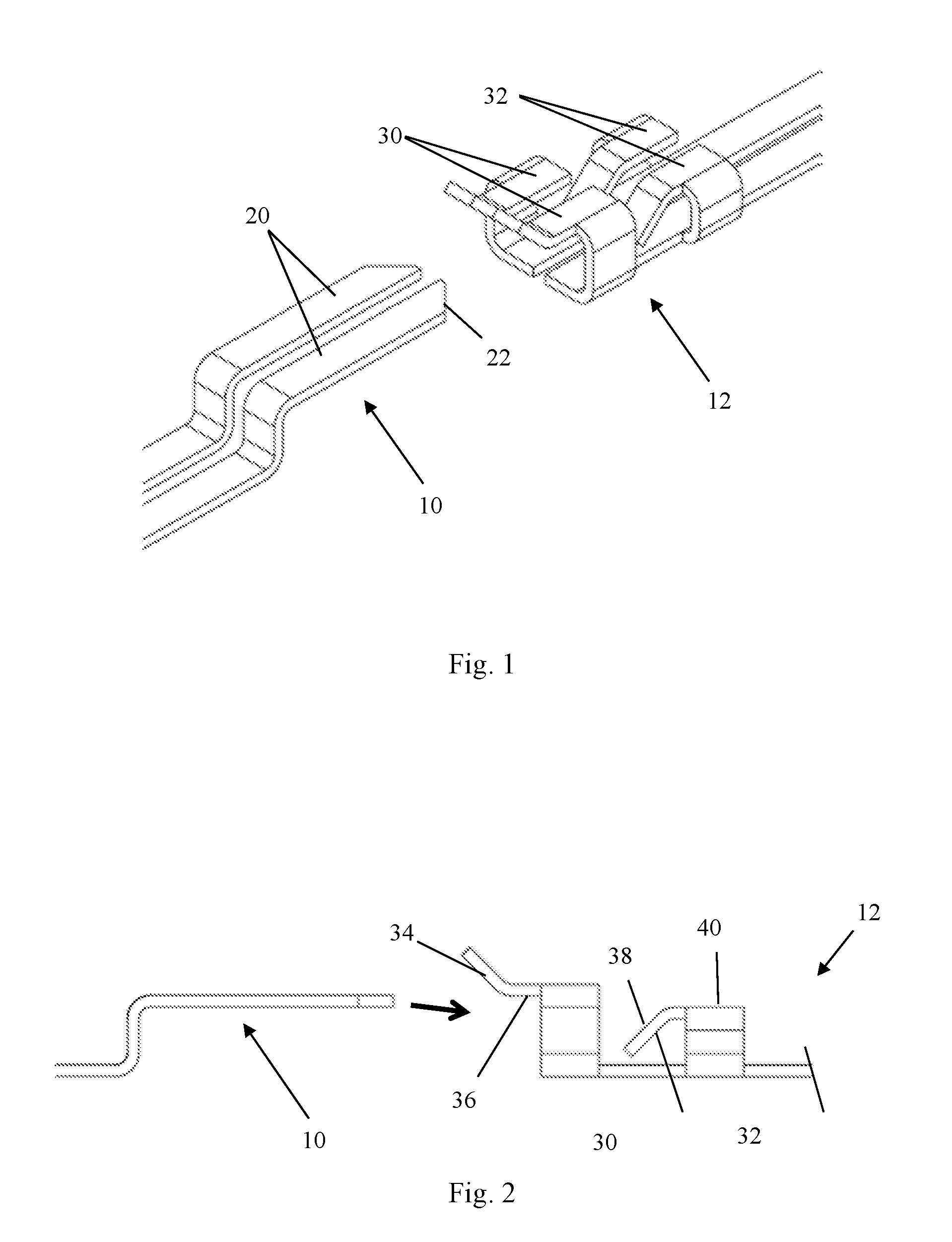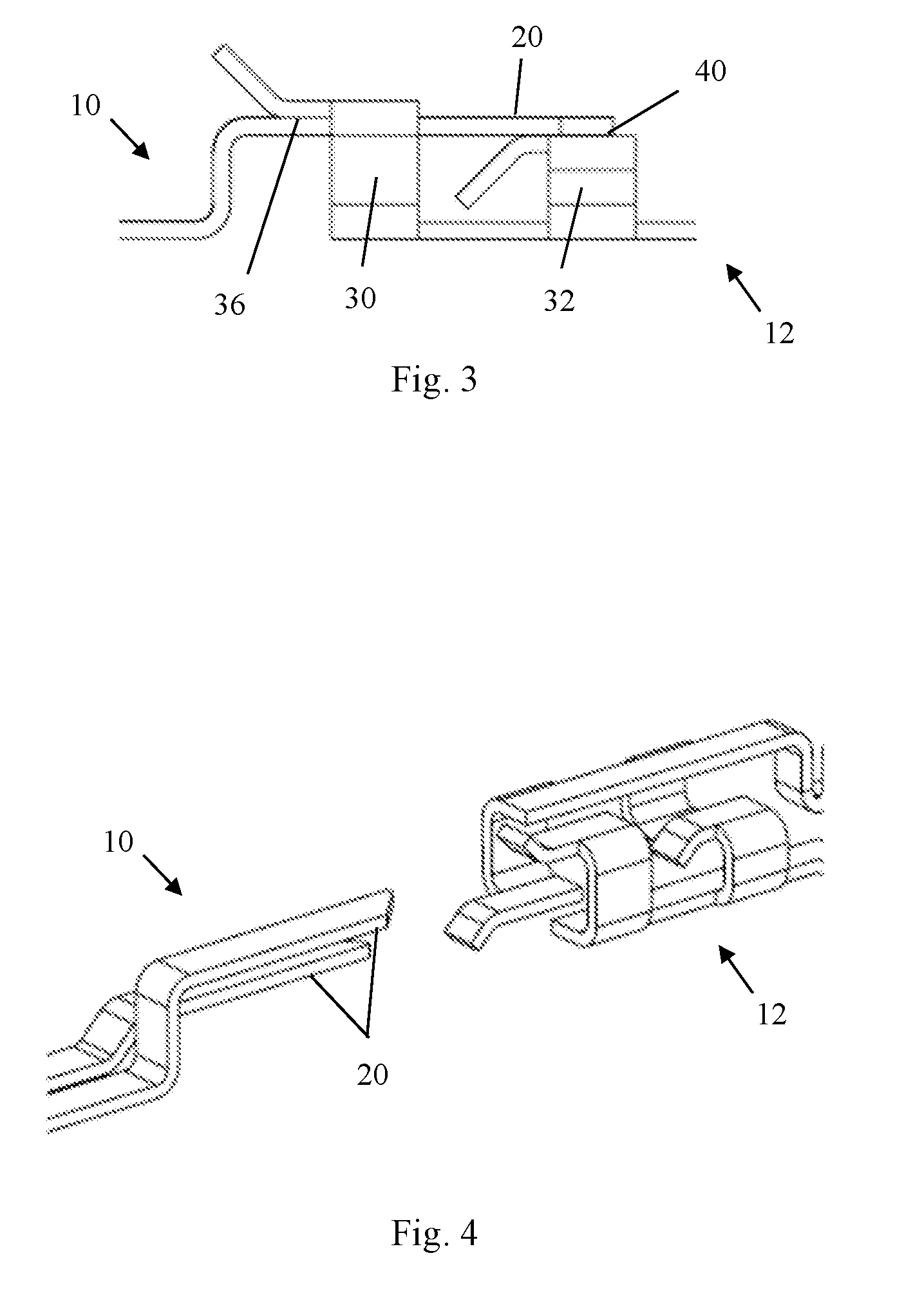Double Wiping Blade Contact
Novak; Benjamin S.
U.S. patent application number 16/381057 was filed with the patent office on 2019-10-17 for double wiping blade contact. This patent application is currently assigned to Panduit Corp.. The applicant listed for this patent is Panduit Corp.. Invention is credited to Benjamin S. Novak.
| Application Number | 20190319378 16/381057 |
| Document ID | / |
| Family ID | 68160523 |
| Filed Date | 2019-10-17 |



| United States Patent Application | 20190319378 |
| Kind Code | A1 |
| Novak; Benjamin S. | October 17, 2019 |
Double Wiping Blade Contact
Abstract
A double wiping blade contact assembly has a blade contact and a double wiping contact. The double wiping contact has first and second stage contact wiping areas. The second stage being at a distance from the first stage and wherein the first stage contact wiping area has an upper lead-in flange that guides the blade contact under the first stage contact wiping area and the second stage contact wiping area has a lower lead-in flange that guides the blade contact over the second stage contact wiping area.
| Inventors: | Novak; Benjamin S.; (Lockport, IL) | ||||||||||
| Applicant: |
|
||||||||||
|---|---|---|---|---|---|---|---|---|---|---|---|
| Assignee: | Panduit Corp. Tinley Park IL |
||||||||||
| Family ID: | 68160523 | ||||||||||
| Appl. No.: | 16/381057 | ||||||||||
| Filed: | April 11, 2019 |
Related U.S. Patent Documents
| Application Number | Filing Date | Patent Number | ||
|---|---|---|---|---|
| 62656424 | Apr 12, 2018 | |||
| Current U.S. Class: | 1/1 |
| Current CPC Class: | H01R 12/50 20130101; H01R 12/85 20130101; H01R 12/7017 20130101; H01R 13/26 20130101 |
| International Class: | H01R 12/50 20060101 H01R012/50; H01R 12/70 20060101 H01R012/70 |
Claims
1. A double wiping blade contact assembly comprising: at least one blade contact; and at least one double wiping contact configured to engage each at least one blade contact wherein the each at least one double wiping contact has first and second stage contact wiping areas, the second stage being at a distance from the first stage wherein the first stage contact wiping area has an upper lead-in flange that guides the blade contact under the first stage contact wiping area and the second stage contact wiping area has a lower lead-in flange that guides the blade contact over the second stage contact wiping area.
2. The double wiping contact assembly of claim 1 wherein the at least one blade contact comprises first and second blade contacts and the at least one double wiping contact comprises first and second double wiping contacts.
3. The double wiping contact assembly of claim 2 wherein the first double wiping contact is a mirror image of the second double wiping contact.
4. The double wiping contact assembly of claim 2 wherein the first blade contact is offset from the second blade contact.
5. The double wiping contact assemble of claim 4 wherein the first double wiping blade contact is inverted relative the second double wiping blade contact.
Description
CROSS REFERENCE TO RELATED APPLICATIONS
[0001] This application claims priority to U.S. Provisional Application No. 62/656,424, filed Apr. 12, 2018, the subject matter of which is hereby incorporated by reference in its entirety.
BACKGROUND
[0002] Copper connectors are becoming increasingly compact in an effort to achieve a higher density of data channels in a given area, as well as for use in applications where data needs to be transmitted to remote devices, such as security cameras and climate control devices. These compact connectors are generally required to be low cost and relatively simple to manufacture, yet be robust enough to handle connecting and disconnecting under load with no performance degradation.
[0003] What is needed is an electrical contact design that can be adapted to a small form factor that is simple and inexpensive to manufacture while featuring multiple points of contact to establish a robust electrical connection.
SUMMARY
[0004] A double wiping blade contact assembly has a blade contact and a double wiping contact. The double wiping contact has first and second stage contact wiping areas. The second stage being at a distance from the first stage and wherein the first stage contact wiping area has an upper lead-in flange that guides the blade contact under the first stage contact wiping area and the second stage contact wiping area has a lower lead-in flange that guides the blade contact over the second stage contact wiping area.
BRIEF DESCRIPTION OF THE FIGURES
[0005] FIG. 1 is an isometric view of a first embodiment of a double wiping contact assembly.
[0006] FIGS. 2 and 3 are a side views of the double wiping contact assembly of claim 1.
[0007] FIG. 4 is a an isomstriv view of a second embodiment of a double wiping contact assembly.
DESCRIPTION OF THE INVENTION
[0008] The present invention is an electrical contact interface that is comprised of a plurality of two different contacts that touch at two or more different points as their respective connectors are mated together.
[0009] FIG. 1 shows a first embodiment of a double wiping contact assembly which includes a pair of blade contacts 10 and a pair of double wiping contacts 12. The blade contacts 10 will be contained in a connector housing, and the double wiping contacts 12 will be contained in the corresponding mating connector housing. The blade contacts 10 feature long horizontal blades 20 with chamfered leading edges 22. The double wiping contacts 12 each have first stage contacts 30 and second stage contacts 32 that touch the top and bottom surfaces of the blade contacts 10 to establish electrical connection.
[0010] FIG. 2 shows a side profile view of the contacts prior to mating. The first stage contacts 30 of double wiping contacts 12 have upper lead-in flanges 34 that guide the blade contacts 10 under the first wiping contact area 36. The second stage contacts 32 have lower lead-in flanges 38 that guide the blade contacts 10 over the second wiping contact area 40.
[0011] FIG. 3 shows the contacts after being mated together. As the horizontal blades 20 of blade contact 10 are inserted into double wiping contacts 12, they make initial contact with first stage contacts 30. During connection under load, this initial point of contact experiences damage from electrical arc between the two surfaces. As the blade contact 10 continues to be inserted, the horizontal blades 20 slide along the first wiping contact area 36 which keeps constant contact with the blades. The horizontal blades 20 then enter the second stage contacts 32, where the underside of the blades slide along the second wiping contact area 40. This design allows the final point of contact to be located away from the portion of the contacts that was damaged during insertion, creating a more reliable and robust connection. The heights of the first and second stage wiping contacts may also be tuned to increase or decrease the normal force applied on the horizontal blades 20 of blade contact 10 as needed.
[0012] To reduce the risk of the blade contacts touching and shorting on each other, they may be offset. FIG. 4 shows a second embodiment of a double wiping contact assembly with the contact interface with horizontal blades 20 of blade contact 10 offset at different heights to increase the space between the blades. To match the heights of the blades, one of the wiping contacts 12 may be inverted.
[0013] While particular embodiments and applications of the present invention have been illustrated and described, it is to be understood that the invention is not limited to the precise construction and compositions disclosed herein and that various modifications, changes, and variations may be apparent from the foregoing without departing from the spirit and scope of the invention as described.
* * * * *
D00000

D00001

D00002

XML
uspto.report is an independent third-party trademark research tool that is not affiliated, endorsed, or sponsored by the United States Patent and Trademark Office (USPTO) or any other governmental organization. The information provided by uspto.report is based on publicly available data at the time of writing and is intended for informational purposes only.
While we strive to provide accurate and up-to-date information, we do not guarantee the accuracy, completeness, reliability, or suitability of the information displayed on this site. The use of this site is at your own risk. Any reliance you place on such information is therefore strictly at your own risk.
All official trademark data, including owner information, should be verified by visiting the official USPTO website at www.uspto.gov. This site is not intended to replace professional legal advice and should not be used as a substitute for consulting with a legal professional who is knowledgeable about trademark law.